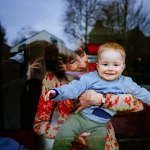Quilting is a labor of love. It’s one of the most tedious craft arts I know but the number of steps I have to take with my pieces only brings me closer to them. There is a lot to learn. Much of it must be done through trial and error. I’ve encountered a lot of snags in my quilt making but machine maintenance, fraying and photography were some of my larger stumbling blocks. Read my tips on these areas to help your quilting be a cut above the rest.
With machine quilting your machine is your livelihood. It’s important to keep in top condition. Whenever you aren’t using the machine, have it covered. Dust, lint and hair are the greatest enemies of a sewing machine. You should get in the practice of cleaning your sewing machine after each project. Remove the needle plate and clean the inside like you mean it—toothbrushes work great. Have your machine serviced once and year and don’t forget to oil it regularly yourself. While operating, change your needle regularly. A sewing machine needle shouldn’t last more than eight hours of work.
My favorite thing about quilting is the variety of materials you can pull together. With all the odd places I gather fabric from, washing is necessary. Unfortunately, washing and drying loose fabric pieces can ruin them if done improperly. Before washing make sure that your fabric is free of any strings. If washed (or worst, dried) with fraying string then the pieces will further unravel. The string can also tangle around the fabric piece and it will crumple like an accordion. This is even worse with constructed sections. The heat of the dryer will pull these excess strands and the section could be ruined. Before washing your quilt pieces carefully trim each edge. You don’t need to cut off a lot of fabric, but make your cuts complete. Throwing your sections in the wash with fresh edges will make all the difference.
Photographing fabric and fiber can be difficult. The texture of a quilt is one of its most amazing qualities, but shoddy photography can leave it looking flat. Using a flash bulb will eliminate shadows from the picture—eliminating the appearance of depth. To photograph your fabric works shoot them at an angle. Forty-five degrees is about perfect. The angle helps create small shadows, making the texture pop. Choose light carefully. Using the light in your home can alter the color of your work. It will look bluer or more yellow depending on the bulb. Natural light is the best. See if you can get natural light coming from just one source. Early morning and late evening sun are ideal.
About The Author
Danielle is an avid crafter who blogs on behalf of Sears and other prestigious brands. From happy stitching accidents to destroying a wool quilt in the washing machines, she has had quite a bit of creation drama. But for love of craft she will be buried with her hot glue gun. Read her work at Eat Breathe Blog
Latest posts by Tammy (see all)
- Grandparents Raising Their Own Grandchildren – A Helpful and Healthy Resource Guide - December 6, 2021
- The Gramma In a Box Review – Ideal For Long Distance Grandma’s - November 18, 2021
- How Senior Citizens Can Network Better - November 8, 2021







